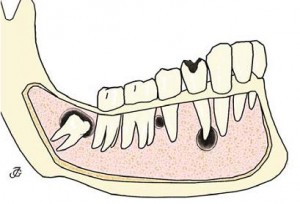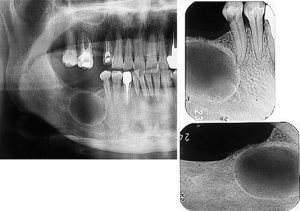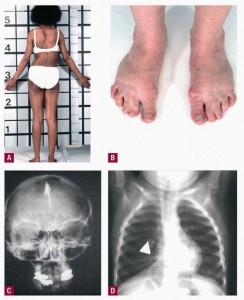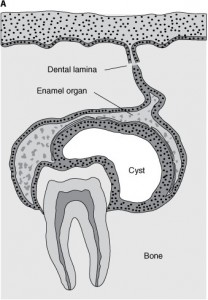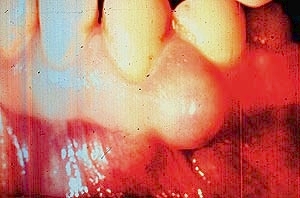Swellings and lumps in the mouth are common. Some may be just anatomical structures in the mouth while some may be of other origin, including jaw cysts.
What is a cyst?
A cyst is defined as a pathological or diseased cavity having liquid, semi-liquid or gaseous contents. It is frequently, but not always, lined with epithelium (Membranous tissue covering internal organs and other internal surfaces of the body). Cysts of the jaw mostly arise from odontogenic epithelium and are relatively common while non-odontogenic developmental cysts are uncommon.
Although the origination and development of many of these cysts are poorly understood, they are divided into two man groups depending on the origin of the lining epithelium.
- Odontogenic cysts – the epithelial lining is derived from the epithelial residues of the tooth-forming organ. They can be subdivided into developmental and inflammatory types depending on the causative factors. At least 90% of all jaw cysts are of odontogenic origin.
- Non-odontogenic cysts – the epithelial lining is derived from sources other than the tooth-forming organ.
Classification of cysts of the jaws
Epithelial cysts |
Non-epithelial cyst |
|
Odontogenic cysts |
Non-odontogenic cysts |
|
Developmental
|
|
|
Inflammatory
|
|
|
Theories of cyst expansion
- Hydrostatic theory – the cyst wall acts as a semi-permeable membrane which draws fluid only from the outside to inside and thereby promotes expansion of the cyst.
- Proliferation or rapid increase in number of epithelial lining – surface area of cystic sac increases by division of cells surrounding the cyst.
- Prostaglandin theory – as the epithelial cells divide, the cyst is able to enlarge within the rigid bony cavity by the release of bone resorption factors from the capsule which stimulates the breakdown of bone cells.
Odontogenic keratocyst
Odontogenic keratocysts occur over a wide age range but there is pronounced peak incidence in the 2nd and 3rd decade with a second smaller peak in the 5th decade. The cysts are more common in males and 70% occur in the wisdom tooth and ramus region of the lower jaw.
Keratocysts give rise to few symptoms. They enlarge predominantly in an antero-posterior (forward to backward) direction. Therefore keratocysts can reach large sizes without causing gross bony expansion.
The majority of keratocysts present as solitary lesions. Multiple cysts are associated with the nevoid basal cell carcinoma syndrome (Gorlin syndrome). It has numerous manifestations including:
- Oral – multiple odontogenic keratocysts, cleft lip or palate
- Skin – multiple nevoid basal cell carcinoma
- Skeletal – rib anomalies, vertebral deformities, polydactyly (Birth defect characterized by the presence of more than the normal number of fingers or toes)
- Central nervous system – calcified falx cerebri, brain tumors
An important clinical feature of keratocysts is the tendency to recur after surgical treatment.
Reasons for recurrence related to difficulty of surgical removal
- Thin and fragile cystic epithelium
- Has satellite cysts (daughter cysts)
- Epithelial lining has intrinsic growth potential
- Has increased mitotic activity
- Patients with nevoid basal cell syndrome have particularly tendency for recurrence of keratocysts
Dentigerous and eruption cysts
Dentigerous cyst is one which encloses part or all of an unerupted crown of a tooth. It is attached to the junction where the tooth enamel meets the root (amelocemental junction) and arises in the follicular tissues covering the fully formed crown of the unerupted tooth. The eruption cyst is the soft tissue analogue of the follicular cyst.
Clinical features
Dentigerous cysts occur over a wide age range and although many are detected in adolescents and young adults, there is an increasing prevalence up to the 5th decade. They are more common in males and in the lower jaw. The cysts most frequently involve teeth which are commonly impacted or erupt late.
The cyst may go undetected until it has enlarged sufficiently to produce expansion of the jaw. Pain is not a feature unless there is secondary inflammation.
Eruption cysts involve both the primary and permanent teeth. They present as a bluish gray swelling of the mucosa over an erupting tooth.
Developmental lateral periodontal cyst
The developmental lateral periodontal cyst is an uncommon lesion that occurs mainly in the canine and premolar region of the lower jaw in middle-aged individuals.
Gingival cyst
Gingival cysts are common in newborns where they are often referred to as Bohn’s nodules or Epstein’s pearls. Most disappear spontaneously by the age of 3 months. Gingival cysts in adults are rare.
To be continued in Part 2.
